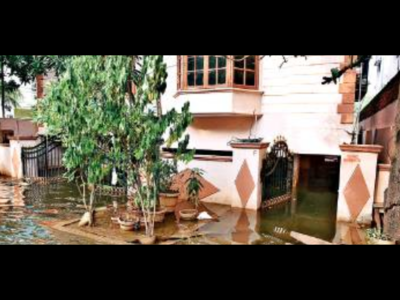The Hindu 08.11.2010
Painting the town red and white
Karunya Keshav
|
20-foot-tall scenes from folk art adorn walls of an underpass in |
— Photo: K. Gopinathan

Kitsch to classy:The wall paintings on the West of Chord Road-Magadi
Road underpass have been executed and supervised by a professional
artist.
Bangalore: For the more sensitive Bangalorean enervated by the
confused proportions of the apsaras, elephants, gomateshwaras and
exhortations against spousal abuse that adorn some of our city walls,
the striking images on an underpass in northwest Bangalore would come as
a pleasant surprise.
Thanks to the Bruhat Bangalore Mahanagara Palike’s ‘Karnataka
Vaibhava’ beautification initiative taken up last year, the whole
stretch of West of Chord Road is a riot of public funded kitsch. So, the
minimalistic rust, white and “yellow ochre” of the painting work in
progress along a small stretch of the West of Chord Road-Magadi Road
underpass, towards Rajajinagar, immediately stands out.
The 20-foot-tall works depict scenes of rural life and nature, in the
distinct Warli style as well as that of Karnataka’s folk art forms.
Commissioned by the Bangalore Development Authority that has
constructed the underpass, BDA Public Relations Officer K. Puttaswamy
says the wall-paintings are a continuation of the work started by
Commissioner Bharat Lal Meena when he was in the BBMP. The project was
sanctioned to promote “heritage paintings”, with special emphasis on
making the paintings “visually and aesthetically pleasing”, he adds.
According to him, this project was sanctioned at Rs. 9 a sq. ft with an estimated 3,000 sq. ft of wall to cover.
Only this time, the wall painting has been executed and supervised by
a professional artist, who was chosen following a tender process over a
month ago.
Making art accessible
C. Ramesh (38), a fine arts professional from Bangalore trained in
visual communication, has made these walls his canvas. He says he hopes
to make the public road, “a kind of gallery for folk art”.
“Art usually becomes part of private collections and is inaccessible.
[With public art], at least the public can see our culture. It is
education cum art,” he says.
A team of around 10 is involved in the project, many of them trained in the fine arts, other painters hired at a weekly rate.
While acknowledging that most people would zip past with barely more
than a glance – indeed, anything more may be dangerous – Mr. Ramesh
believes that rather than being a distraction, the use of white paint
and simple colours would come as a “visual relief” to motorists.
Surrounded by Namma Metro barricades and dug up roads, these
paintings may be the only visual relief for the few commuters venturing
here for now.
Manasa Prakash, an engineer who lives and works in the area,
immediately identifies the images as those in vogue after being featured
in a recent advertisement. “They’re beautiful. I’d also like to see
more rangoli designs,” she says.
Rekha Achar, an architect and road user from Vijaynagar, thinks the
works are “very different”, as compared to the “childish” ones elsewhere
in the city. But she cautions against plastering the city walls with
more of the same. “The paintings look good because they are 20 ft tall. A
similar pattern on a smaller wall may not be such a good idea.”


